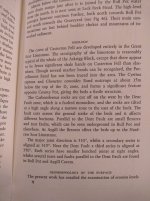Sounds like it's potentially (but not necessarily) porcellanous limestone.
The best known one is that seen in GG Main Chamber (and much of the system) but there are others within the Great Scar Limestone sequence.
Have you got a sample? If so,on a freshly broken surface look for a dull texture with an absence of crystals (no obvious sparkling, like porcelein). Also a tendency towards conchoidal (shell like) fracture.
Or you could try the "Dick Glover Lick Test". If you lick a freshly broken surface (I kid you not) Dick Glover always maintained that porcellanous limestone will not change colour whereas normal sparry limestone will.
Without checking (in the middle of cooking as I type) you may find some information on the location of porcellanous beds in the Casterton area caves in the Waltham / Lowe book Caves & Karst of the Yorkshire Dales. Best to be aware that it's not only porcellanous limestone which can weather to a distinct whitish shade. This is why it's important to look at a freshly broken sample.
This picture shows a sample with normal sparry limestone at the top and porcellanous limestone at the bottom, for comparison. Zoom in to see the detail. Hope this helps.




